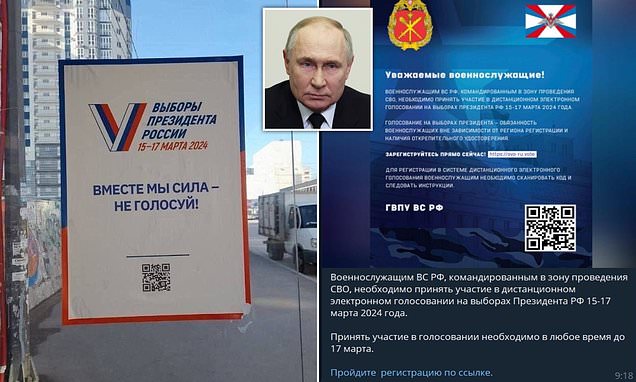By Miriam Kuepper
During Vladimir Putin’s attempt to solidify his authority in Russia through a fraudulent presidential election, resistance movements within occupied Ukraine created turmoil for the Russian forces.
In the southern and eastern occupied regions, a group known as the ‘digital partisans’ displayed courage both on the ground and through digital means to disrupt and outsmart the Russians at every step.
They utilized fake websites to disrupt the ‘electoral’ procedures, distributed leaflets deep within the occupied territories urging people not to participate in the election, and employed deep fake videos to sow discord among the local collaborationist authorities.
Even Russian military personnel in the occupied areas fell victim to a clever ploy where they unknowingly provided personal information on fake websites to the resistance.
Soldiers deployed by Moscow had the option to vote in person only. Exploiting this, various resistance factions launched a coordinated effort to take advantage of this restriction.
One group set up a deceptive website labeled ‘only for the military,’ enticing soldiers to register for online voting by entering personal details such as their name, military ID, and passport information. They also distributed leaflets containing a QR code leading to the fake website.
Through insider sources within the Russian military, they acquired the personal details of active Russian personnel and sent fabricated direct messages, purportedly from the Chief Military Political Department of the Russian Armed Forces, instructing them to participate in remote electronic voting for the presidential elections.
This operation proved successful as soldiers unknowingly divulged their personal information during registration, subsequently believing they had voted online and thus abstaining from in-person voting.
Although the activists understood that their actions wouldn’t alter the predetermined outcome of the election, which saw Vladimir Putin secure an overwhelming 88% of the vote, their objective was to expose the facade of democracy perpetuated by the Kremlin.
The resistance campaign commenced in mid-February with the creation of Telegram channels mimicking the regional ‘elections commissions’ in the occupied territories, garnering more members than the authentic channels.
Another strategy involved distributing leaflets with a simple yet impactful message: ‘We are together. Don’t vote.’ This message was based on the constitutional right in Russia to abstain from voting.
By scanning the QR code on the leaflets, individuals were directed to a page on the Russian State News Agency TASS website, highlighting the violations of Putin’s military operation.
The resistance also established fake Telegram channels for election commissions in Donetsk, Luhansk, Zaporizhzhia, and Kherson, spreading misinformation that voters could book time slots for voting, resulting in chaos on election day.
The Russians retaliated by contacting website administrators to shut down the fake military and local online voting platforms. Marina Zakharova, head of the Election Commission in the Kherson region, condemned the resistance’s efforts to undermine the election process.
Numerous local channels, including authorities in small villages within the occupied territories, were compelled to clarify the distinction between the original and cloned Telegram channels, as failure to manage the election appropriately could have repercussions for their positions in Moscow.
Throughout their resistance activities, the opposition sought to exploit divisions among the occupying authorities and expose the darker aspects of the Russian presence in Ukraine.
One concerning development was the influx of criminals into Ukraine, facilitated by Russia through groups like Wagner, who offered criminals a chance at freedom in exchange for military service in the occupied territories.
The resistance managed to obtain the criminal records of these individuals and publicly broadcast them, shedding light on the disturbing practice of importing violent offenders into Ukraine under the guise of military service.
In a bold move, the digital partisans even created a deep fake video featuring the quisling governor of the occupied Zaporozhye Region, further fueling confusion among the Russian forces.
These collective efforts underscore the unwavering resistance of Ukrainians against the occupation, supported by a network of informants providing crucial information to thwart Russian operations.
Through a series of videos, the resistance highlighted the incompetence of local Russian authorities in managing essential services such as waste disposal, water supply, and public transportation, resonating deeply with the local population.
The meticulously executed campaign of sabotage and misinformation disrupted the Russians’ plans for a seamless sham election in the occupied territories, forcing them to confront public scrutiny and resistance at every turn.
In the face of occupation, the message remains clear: Ukraine continues to resist despite the challenges posed by the occupying forces.










